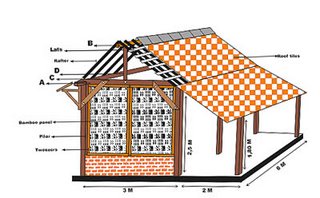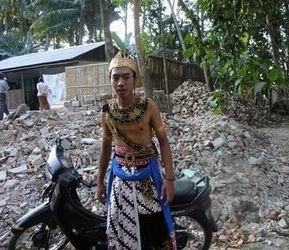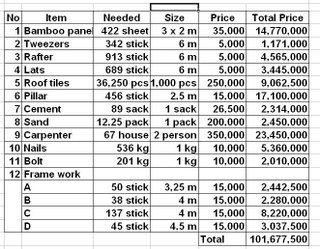BEBEKAN 11
 A week ago, we completed the inventory of the additional materials needed for each house. Before purchasing these materials, we waited to see whether the assistance promised by the government would be granted or not. Each day, the provincial authorities contradict themselves, hesitate, change their mind. The dominant plan for the moment is to grant the amount of 15 million Rupiah (1,400 euros) for each destroyed house, but in three stages: the first stage at the beginning of September for 32,000 houses (it is now already August 27 and the money is still not available for unspecified bureaucratic reasons), the second payment in November for approximately 50,000 houses, and the third payment from January 2007 until June 2007 for the remaining 100,000 houses. Obviously, the population started to protest: why not do the same as the province of Central Java which decided to give all the houses a single payment of 4.5 million. To this objection, the Sultan (who is the Governor of the Province of Yogyakarta) answers that the authorities want to have teams of architects and technicians supervise the work of rebuilding to make sure that the houses will be rebuilt according to earthquake-resistant standards. If a lesser amount is given to all at the same time, this control will be impossible, because, on the one hand, this amount of 4.5 million Rupiah (420 euros) could not be enough to build a permanent house, and furthermore because the provincial authorities could not possibly supervise the construction of nearly 200.000 houses in only one stage : it would be too much to handle. To this argument, the population answers that it does not trust the provincial authorities, and that the second and third payments are likely never to take place. The victims of the earthquake have already had the bitter experience of the 90,000 Rupiah monthly allowance which was to be given to them for three months, accompanied by 10 kilos of rice per month and per person. In the end, most people only got one month of allowance and the people of Bebekan told us that when they opened the rice bags, the rice was being devoured by insects. They were just old stocks that could only be given to cattle or poultry. By reselling this rice as animal feed, they got enough to buy 3 kilos of rice edible by humans.
A week ago, we completed the inventory of the additional materials needed for each house. Before purchasing these materials, we waited to see whether the assistance promised by the government would be granted or not. Each day, the provincial authorities contradict themselves, hesitate, change their mind. The dominant plan for the moment is to grant the amount of 15 million Rupiah (1,400 euros) for each destroyed house, but in three stages: the first stage at the beginning of September for 32,000 houses (it is now already August 27 and the money is still not available for unspecified bureaucratic reasons), the second payment in November for approximately 50,000 houses, and the third payment from January 2007 until June 2007 for the remaining 100,000 houses. Obviously, the population started to protest: why not do the same as the province of Central Java which decided to give all the houses a single payment of 4.5 million. To this objection, the Sultan (who is the Governor of the Province of Yogyakarta) answers that the authorities want to have teams of architects and technicians supervise the work of rebuilding to make sure that the houses will be rebuilt according to earthquake-resistant standards. If a lesser amount is given to all at the same time, this control will be impossible, because, on the one hand, this amount of 4.5 million Rupiah (420 euros) could not be enough to build a permanent house, and furthermore because the provincial authorities could not possibly supervise the construction of nearly 200.000 houses in only one stage : it would be too much to handle. To this argument, the population answers that it does not trust the provincial authorities, and that the second and third payments are likely never to take place. The victims of the earthquake have already had the bitter experience of the 90,000 Rupiah monthly allowance which was to be given to them for three months, accompanied by 10 kilos of rice per month and per person. In the end, most people only got one month of allowance and the people of Bebekan told us that when they opened the rice bags, the rice was being devoured by insects. They were just old stocks that could only be given to cattle or poultry. By reselling this rice as animal feed, they got enough to buy 3 kilos of rice edible by humans.Since the rainy season will start in two months, we decided to start buying next week the coconut-wood pillars and beams for the frame. These are the materials missing for the majority of the houses, and they will allow building the vital basic structure which the people of Bebekan can then complete, according to their means, with bamboo panels and salvaged bricks. If we have the means, we will of course help them to complete the construction. To maintain fairness, the houses which do not need pillars or new frames will get the equivalent out of cement, sand or other needed materials.
We also will pay the 5 or 6 carpenters of the village so that they can in shifts of three or four (maximum) days per house. This should be enough for the construction of the frame. We also will buy one or two power saws and other related tools to facilitate and accelerate their work.

Three days ago, we went to a free consultation on earthquake-resistant buildings organized by the CEEDEDS (Center for Earthquake, Engineering, Dynamic Effect and Disaster) which is under the wing of the Indonesian Islamic University of Yogyakarta. We showed them the plan of “our” basic simplified house and they gave us two valuable advice :
1. Add angled cross-beams to the frame (this technique has a specific name which I forget, but we added these beams on the blue-print of the initial plan).
2. It is very dangerous to build a short (50 cm) supporting brick wall without a foundation (it was designed such by us because it is a non-permanent wall). In the event of an earthquake, the tension of this short brick wall would pull along the pillars in its fall. But if we remove this short wall, the bamboo panels will have to rest directly on the ground and they will quickly become wet and will be destroyed by the rain. The solution is to keep this short brick-wall without making it cling to the pillars, by leaving a space of a few centimeters between the wall and the pillars. We will discuss he matter with the men of Bebekan. In 2003, the CEEDEDS published a very good booklet on earthquake-resistant buildings in collaboration with the Japanese government. We bought several copies for Bebekan.
Meanwhile, on the NGO front, Cardi, which had already promised a month ago “to wrap” six or more public WC, has only just now, it seems, received the money necessary for this project and will bring the materials in one month! On the other hand, a local Indonesian NGO donated 167 bamboo panels, an amount which we can then remove from our inventory. These panels were distributed on the basis of individual needs, according to our house by house survey.
The toilet adjoining the mosque has been completed. Two weeks ago, when I went to see the men digging the septic tank, they showed me to what extent the ground was black, incredibly black and full of white spots. They had already reached a depth of two meters when they found a shell. They told me that this was indeed the proof that the legend of Bebekan (which means duck in Indonesian) was true: a thousand years ago, the village was a ground marsh, well suited to the breeding of thousands of ducks. The ocean has since withdrawn to 15 km in the south. By digging the ground, one digs history.

For the festivities of Independence Day, August 17, there was a village fair with games. The committee of young people of Bebekan organized everything, and we supported them by buying the victory prizes. Nothing superfluous : books, pencils for the children; pots, plates, plastic basins for the women. Usually, the games are organized for the children only. When I suggested that the women take part too, they at once formed two groups : those less than 40 years old and those more than 40. The oldest was 75, and she took part in the marathon and the game of tug-of-war : eleven women pulling on a rope from one side, eleven from the other. At the last moment, a game for the men was added, the grease pole game : they suspended the trunk of a banana tree vertically by tying it to a rope stretched between two trees and coated it with black oil, very sticky and... very slippery.

On Sunday August 19, always within the context the Independence Day festivities, the men of Bebekan took the initiative to perform a Reog performance on the esplanade of the volleyball court, located at a short distance outside the village. We had prepared a surprise for them: Asep had been for a long time working on a logo for Bebekan illustrating the legend of the two ducks in love next to the water spring in the middle of the rice fields. We printed this logo on two flags and offered them to the village. But the people of Bebekan also had a surprise for me : for the opening of the (free) Reog performance, they invited me to hang one of the flags to the spear carried by a girl. Two girls of Bebekan have indeed joined the group of reog which until now had been exclusively male ! I certainly hope that others will follow. The other girl carried at the end of her spear the red-and-white Indonesian flag. The flag of Bebekan can be seen on the blog entry titled “Bebekan 11". Telling the story of this performance would take up too much space in this letter. So I will prepare another text on the subject and will send it to you in a few days. It will focus on the trance phenomenon in Bebekan, and I must say it demolished all the prefabricated ideas I had until now about this. The reog of Bebekan was such a success that the group was invited to perform on this Sunday August 27 in a neighboring village for 1 million Rupiah (90 euros). Since there are more than sixty performers in the group, it doesn't amount to much per performer. Moreover, part of this sum will be deposited in the community chest in order to pay for snacks and drinks during the rehearsals.
We will meet Tuesday August 29 in Bebekan to discuss specifically the management of this chest and talk about the one-year training program suggested by Mas Besar, a great dancer from Yogyakarta, with several friends of his, musicians, costume designers and make-up artists. I will let you know eventually what happened in this meeting.
 In the middle of these festivities, on the night of August 18 to 19, the ground shook again in Yogyakarta. Even if it was a rather weak 3.9 earthquake, its epicenter was very close to the city : the houses were strongly shaken and it triggered a panic among the population. My daughter, Sarah, also panicked. Still half asleep, she fell while running from her bed to the door of her room which opens up directly on the garden. There was only two meters to cross without any obstacles. In her fall, she broke the two bones of her left front-arm : the bones pierced the skin, bored a vein, and blood gushed out. I transported her in the middle of the night to an hospital where she had an emergency operation. When they learned about this accident, the people of Bebekan expressed a moving and genuine compassion. For them, Sarah was a “delayed” victim of the earthquake. A first group of 50 women arrived at the house on Friday afternoon, loaded with boxes of palm sugar, duck eggs, emping, tempe (a pate made from fermented soya beans), fruits. Then the following day, two groups of women, men and children came, again loaded with boxes of food. The two groups had rented a bus with their own money to come all the way to our house. Since on this Saturday, it was the ceremony of the offerings to the Merapi volcano, I brought some eggs, sugar and tempe to the wife of Mbah Marijan, the guardian of the volcano. Water is still not available in their village, a gigantic bag made of sealed tissue (donated by UNICEF) acts as a reservoir and feeds out water to the toilet of the mosque. During the night preceding the offerings ceremony, the great and venerable shadow puppeteer, Timbul, performed in the village of the guardian of the volcano. Timbul lives in the south of Yogyakarta, his house was also destroyed in the earthquake and many gamelan instruments were damaged.
In the middle of these festivities, on the night of August 18 to 19, the ground shook again in Yogyakarta. Even if it was a rather weak 3.9 earthquake, its epicenter was very close to the city : the houses were strongly shaken and it triggered a panic among the population. My daughter, Sarah, also panicked. Still half asleep, she fell while running from her bed to the door of her room which opens up directly on the garden. There was only two meters to cross without any obstacles. In her fall, she broke the two bones of her left front-arm : the bones pierced the skin, bored a vein, and blood gushed out. I transported her in the middle of the night to an hospital where she had an emergency operation. When they learned about this accident, the people of Bebekan expressed a moving and genuine compassion. For them, Sarah was a “delayed” victim of the earthquake. A first group of 50 women arrived at the house on Friday afternoon, loaded with boxes of palm sugar, duck eggs, emping, tempe (a pate made from fermented soya beans), fruits. Then the following day, two groups of women, men and children came, again loaded with boxes of food. The two groups had rented a bus with their own money to come all the way to our house. Since on this Saturday, it was the ceremony of the offerings to the Merapi volcano, I brought some eggs, sugar and tempe to the wife of Mbah Marijan, the guardian of the volcano. Water is still not available in their village, a gigantic bag made of sealed tissue (donated by UNICEF) acts as a reservoir and feeds out water to the toilet of the mosque. During the night preceding the offerings ceremony, the great and venerable shadow puppeteer, Timbul, performed in the village of the guardian of the volcano. Timbul lives in the south of Yogyakarta, his house was also destroyed in the earthquake and many gamelan instruments were damaged.The following day, at dawn, we climbed the path of the offerings skirting the ravine through which lava flowed on June 14. It is as white as a ski trail. The path was covered with ashes which had become a grayish fine sand, very fine. We were wearing masks in order not to suffocate. The volcano was completely visible : under the sun, the slope still shining with ashes and white lava looked like a river of crystal silver.
In a few days, we will post on the blog a list of the friends who supported Bebekan but without indicating the amount contributed.
Here again are the links to the blog.
For the French version :
http://bebekan-e.blogspot.com
For the English version :
http://bebekanvillage.blogspot.com
For the Indonesian version (shortened) :
http://bebekan.blogspot.com

You will find below the inventory of the additional necessary materials, house by house, in English, as well as the total budget. In a few days, you will also find on the blog, the inventory, the budget, the plan of the simple house, and the photographs of each house taken three days after the earthquake and of each current temporary shelter. Each photo is labeled with a number corresponding to the number of the surname registered on the inventory for the RT 1 and the RT 2.
Small lexicon.
Bambou panel : panneau de bambou
Tweezers : bambou fendu (servant de pince)
Rafter : chevron
Lats : lattes
Roof tiles : tuiles
Pillar : piliers (en bois de cocotier)
Cement : ciment
Sand : sable
Framework : charpente
House damages : degré de destruction
totally : totalement
severely : sérieusement
slightly : légrement.

0 Comments:
Post a Comment
<< Home